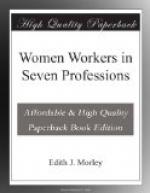“That appointments in suitable offices should be opened to women between the ages of 19 and 24, who have either passed or can pass an examination equivalent to that of male second division clerks, or clerks of the intermediate class, according to the practice of the department in filling its appointments. It seems desirable that the abilities of women who would otherwise be occupied in business, teaching, secretarial and clerical, and other work, much of which is closely comparable with that of second division and intermediate clerks, should be available for the work of the Civil Service, especially in the offices already mentioned in connection with the first division appointments.”
These claims, pertinent as they are, and strongly as they should be urged, need to be extended still further.
Women claim to be admitted to share in the administrative work, not only of those departments directly concerned with women, but also in those in which the work concerns equally men and women as citizens—e.g., the Treasury, the Foreign Office, the Colonial Office, the Inland Revenue. No one could argue that the work of these departments is unsuitable for women, any more than is the work of the General Post Office, in which they have so conspicuously succeeded. Even the War Office, with the charge of so many soldiers’ wives and children living in barracks, removed from the jurisdiction of all civic services, and the control of so large a number of Army Nurses, needs women amongst its administrators.
The claim must also be made quite clearly, that in throwing open these posts to women, the same method of recruiting must be employed as for men, and the remuneration must be at the same rate. In asking for these opportunities women are simply asking that the sex disability which at present bars them from the majority of posts in the service, may be removed. They do not seek admission in some special way, nor do they wish to undercut men by accepting lower salaries. They ask that the sex barrier may be removed in the case of both Class I. and Class II. appointments—in other words, that these appointments may be open to them on the same conditions as they are or may be open to men.
In the case of the majority of the appointments hitherto held by women, some care has been taken to put them on a different footing from those of men; in these instances it is not easy to compare the work of women with that of men, or to urge the claim of women to be paid at the same rate as men for work of equal value. There are, however, some conspicuous instances—e.g., of the Factory Inspectors and Inspectors of Schools—in which no such differentiation is possible and in which the only reason for paying the women less than the men seems to be that given by the ex-Permanent Secretary of the Treasury in his evidence before the Royal Commission on the Civil Service, “that women ought to be got as cheaply as possible, and that if they can be got for less, they ought not to be paid the same as men.”




